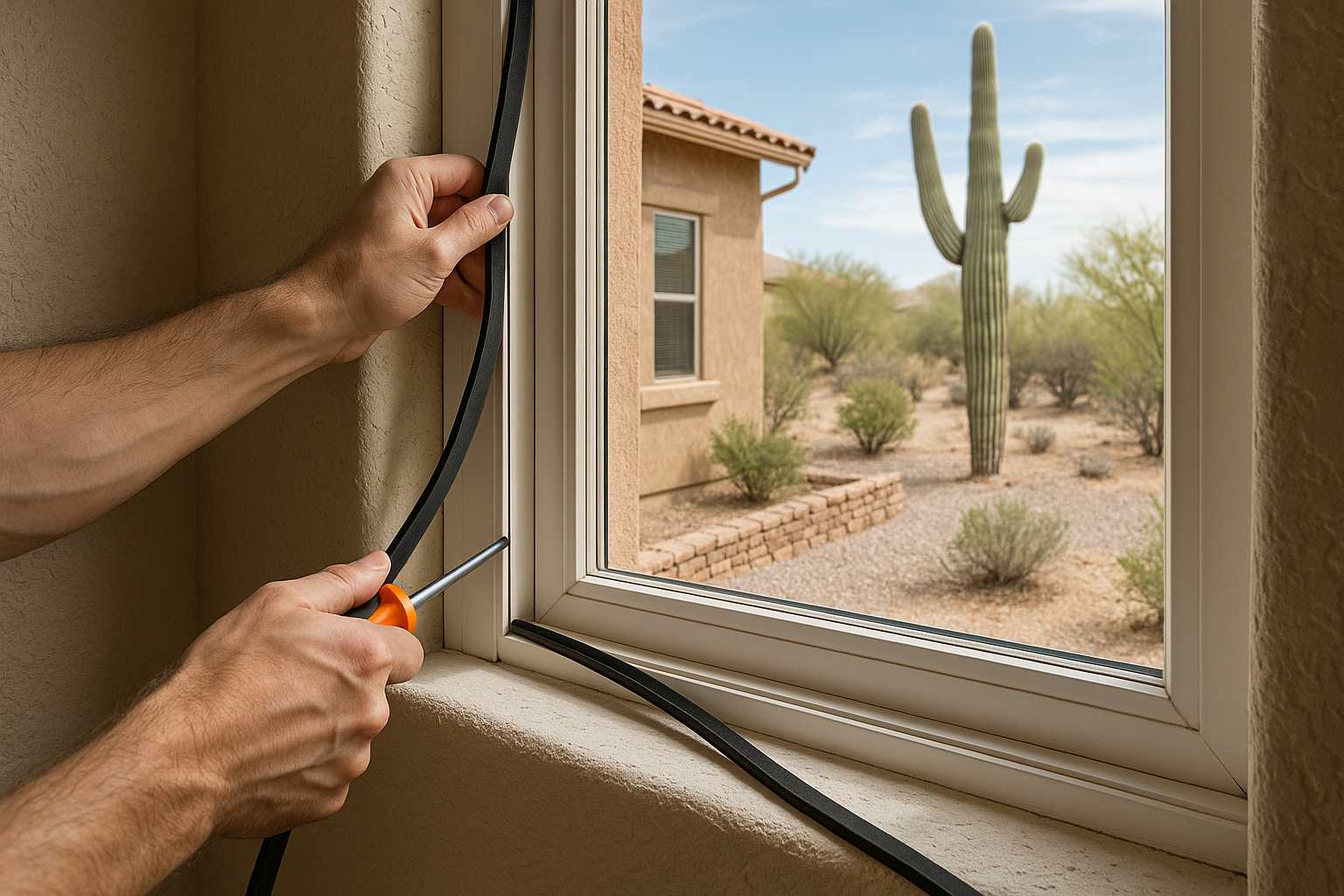Ever walk past your living room window and feel a ghost of a breeze, even when everything is shut tight? It’s an unsettling feeling, especially when you know the A/C is blasting to combat that relentless Maricopa County heat. That invisible draft isn’t just a comfort issue; it’s the sound of your wallet leaking cash.
Contents
Why Should You Care About a Little Draft?
You know what? It’s easy to ignore a rattling window. We get busy, life happens, and a little extra noise from the street seems like a minor annoyance. But here’s the thing: in Arizona, your windows are the frontline defense against the elements. When the seal on that defense fails, your HVAC system has to work overtime.
Think of it like driving your car on the freeway with the A/C on and the windows rolled down an inch. It works, sure, but you’re burning fuel like crazy.
In the Valley, where summer energy bills can already look like a mortgage payment, weatherstripping acts as the silent guardian of your bank account. It’s not just about keeping the cool air in, either. We all know about monsoon season. When those dust storms roll through, a bad window seal means you’ll be dusting grit off your coffee table for weeks.
The “Dollar Bill” Diagnosis
Before you rush out to the hardware store, you need to figure out exactly where the problem is. You don’t need fancy thermal cameras for this. Honestly, the best tools are probably already in your pocket or your kitchen drawer.
Try the Dollar Bill Test:
- Open your window.
- Place a dollar bill on the sill.
- Close and lock the window.
- Try to pull the bill out.
If that dollar slides out with zero resistance, you’ve got a gap. If it rips or stays put, your seal is decent. It’s a crude method, but it works.
Another way to check? The “Candle Test.” Light a candle (or use a lighter, carefully) and move it slowly around the perimeter of the window frame on a windy day. If the flame flickers or bends, you’ve found your leak. Just be careful not to set your curtains on fire—that would definitely fix the draft problem, but not in the way we want.
Choosing Your Weapon: Types of Weatherstripping
Alright, so you’ve found the leak. Now what? Walking down the aisle at a home improvement store can be overwhelming. There are rolls of foam, strips of metal, and tubes of goo. Which one do you grab?
It really depends on the type of window you have and how much work you want to put in. Let’s break it down.
Tension Seal (V-Strip)
This is a durable plastic or metal strip folded into a ‘V’ shape. It springs open to bridge gaps.
- Best for: Double-hung or sliding windows.
- The Vibe: It’s invisible once installed and lasts a long time. It’s a bit fiddly to install, though.
Reinforced Foam
Closed-cell foam attached to wood or metal strips.
- Best for: Door stops and the bottom of window sashes.
- The Vibe: Easy to install, but it can look a little bulky. It stands up well to the wind.
Felt
It’s exactly what it sounds like. Rolls of polyester or wool.
- Best for: Older sash windows where you need a quick, cheap fix.
- The Vibe: Honestly? It’s the budget option. It doesn’t last long, hates moisture, and isn’t great at blocking airflow. But in a pinch, it’s better than nothing.
Tape (Foam or Rubber)
Self-sticking rolls of squishy material.
- Best for: Odd-shaped cracks or when you aren’t handy with tools.
- The Vibe: Super easy. Peel and stick. However, the Arizona heat can sometimes dry out the adhesive, making it peel off after a season or two.
The Arizona Factor: Dust and Dry Rot
Here is something folks elsewhere don’t always get. In the Midwest, weatherstripping is about keeping the freezing cold out. Here in Maricopa County, we are fighting a different battle. We are fighting the sun.
UV radiation destroys everything. It cracks dashboard vinyl, fades paint, and absolutely wrecks rubber window seals. If your windows haven’t been touched in ten years, that rubber seal has likely turned into a brittle, crumbly mess that looks like dried toast.
When you’re inspecting your windows, touch the rubber glazing or the weatherstripping. Does it leave black streaks on your finger? Does it crumble? If yes, it’s done. It’s not sealing anything anymore.
And then there’s the dust. Oh, the dust.
If you have fine silt appearing on your interior sills after a haboob, it’s not just a cleaning annoyance; it’s a sign your weatherstripping has gaps. Those gaps let in allergens and that specific desert dust that seems to get into everything. Replacing your seals is as much about air quality as it is about temperature control.
A Step-by-Step Guide to DIY Sealing
So, you want to tackle this yourself? Good on you. It’s a satisfying weekend project. But don’t just slap some tape on and call it a day. Preparation is ninety percent of the job.
1. Clean the Surface
You can’t stick new weatherstripping to dust or old glue. It just won’t hold. Scrape off the old stuff. Use an adhesive remover if you have to. Then, wash the area with soap and water and let it dry completely. I mean bone dry.
2. Measure Twice, Cut Once
My grandfather used to say this about carpentry, but it applies here too. Measure the gap you need to fill. If the gap is huge and you use a thin tape, you’ve wasted your time. If the gap is tiny and you use thick foam, the window won’t lock.
3. Apply with Pressure
When using self-stick foam, press it down firmly. Don’t stretch it! If you pull it tight while sticking it down, it will eventually shrink back and pull away from the corners.
4. Check the Lock
After you install the strip, close the window and lock it. It should be snug—maybe a little harder to lock than before—but it shouldn’t feel like you’re going to break the handle. If it won’t lock, the stripping is too thick.
When DIY Isn’t Enough
Look, I’m all for saving a buck and fixing things yourself. It feels good. But sometimes, a tube of caulk and a roll of foam tape is like putting a band-aid on a broken leg.
There are times when the window itself is the problem.
- The Foggy View: If you see condensation between the panes of glass, your insulated glass unit (IGU) has failed. No amount of weatherstripping will fix that. The gas has leaked out, and the thermal efficiency is gone.
- Rotten Frames: If you have older wood windows and the frame feels soft or spongy, you’ve got rot. Screwing weatherstripping into rot won’t work.
- Warped Sashes: Sometimes the heat warps vinyl or aluminum frames to the point where they aren’t square anymore. If the window is bowed, a straight strip of tape won’t seal the gap.
In these cases, you’re looking at a repair or replacement job. It sounds scary, but it’s often more cost-effective in the long run than throwing money at energy bills for a house that leaks like a sieve.
Maintenance is Boring (But Necessary)
I know, nobody wakes up on a Saturday excited to inspect their window tracks. It’s tedious. But maintaining your weatherstripping is easier than replacing it.
Keep the tracks clean. Dirt buildup causes friction, which tears up the seals at the bottom of the sash. Lubricate the tracks with a silicone spray (not oil-based, which attracts more dirt) once a year. It keeps things moving smoothly and reduces wear on the seals.
Also, take a look at the exterior caulking—the stuff between the window frame and your stucco or siding. In Phoenix, that caulk dries out and cracks. If you see cracks, water can get behind the frame and into your walls. That is a nightmare scenario you want to avoid. A quick bead of high-quality outdoor caulk can save you thousands in structural repairs later.
Keeping the Valley Heat at Bay
At the end of the day (sorry, had to say it), your home is your sanctuary. It’s where you escape the scorching asphalt and the noise of the city. You deserve to sit on your couch without feeling a hot draft on your neck or hearing the wind whistle a tune through your living room.
Whether it’s a simple Saturday afternoon DIY project with some foam tape or a more serious repair job, taking care of your windows is taking care of your comfort. It changes the feel of the room. It makes the house quieter, cleaner, and cooler.
If you’ve tried the candle test, applied the tape, and you’re still feeling that heat creep in, it might be time to call in the cavalry. Sometimes you need a pro to look at the alignment, the glass, or the frame itself.
Don’t let your A/C cool the entire neighborhood this summer. If you’re stuck, or if the job looks bigger than a quick hardware store run, give us a shout. We know Arizona homes, and we know how to handle Arizona heat.
Ready to seal up your home and lower those bills?
Call us today at 480-526-4456 or click here to Request a Free Quote. Let’s get your windows working for you, not against you.




